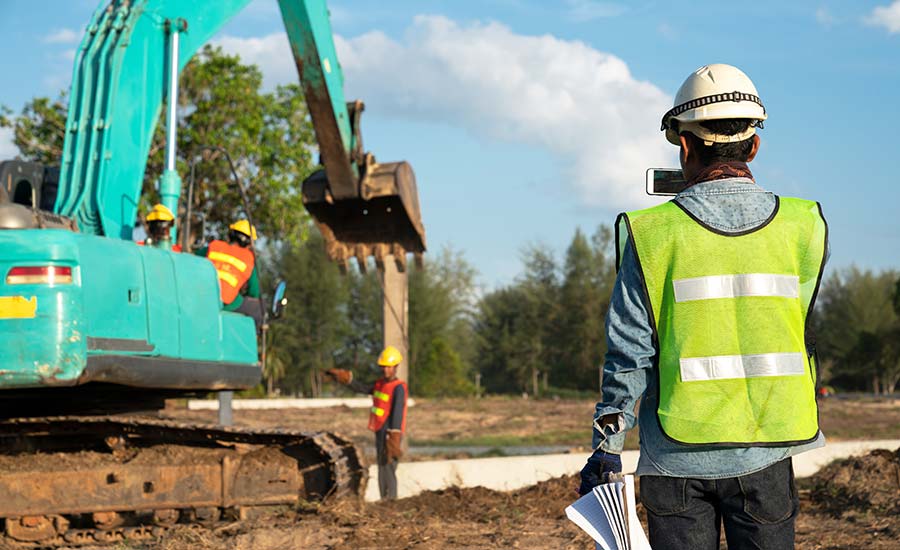
From recording weather conditions to logging work hours, a comprehensive construction daily report is key to tracking progress and ensuring employee safety throughout each project.
We’ll share what a construction daily report should include, cover the key benefits of this type of report, and provide a step-by-step guide to creating your own template.
Plus, we’ll explain how you can simplify your reports by taking the digital route, so you can build, edit, save, and send documents whether you’re at the project site or on the road.
Table of Contents
Create a custom daily construction report template.
Try doForms for free!
What Is A Construction Daily Report?
A construction daily report is a document that summarizes activities and progress during a work day on a construction site.
Typically, this report includes information on:
- The work completed for the day
- The number of employees on-site
- The equipment used
- The materials delivered
- The weather conditions for the day
- Any safety incidents that may have occurred
- Any issues or delays that employees may have encountered
A construction daily report keeps track of the project’s progress and allows project managers and stakeholders to make informed decisions at each stage.

A construction daily report can help provide transparency on a project’s progress
What Industries Use Construction Daily Reports?
From real estate to oil and gas, construction daily reports are used across various industries that deal with construction and development, including:
- Construction industry: Contractors, project managers and site supervisors use daily reports to monitor progress, track issues and make sure the project stays within the time frame and budget.
- Real estate development: Developers of residential, commercial and industrial properties use daily construction reports to ensure that the construction process aligns with the project’s specifications and timelines.
- Civil engineering: Experts involved in infrastructure projects, such as road construction, bridges and utilities, rely on daily construction reports to manage the complexities of large-scale civil engineering and ensure safe and efficient project completion.
- Oil and gas industry: Specialists in construction projects in the oil and gas sector, such as the building of refineries, pipelines and extraction facilities, use construction daily reports to track construction activities, safety measures and regulation compliance.
- Energy sector: Contractors of power plants and renewable energy projects, such as solar and wind projects use daily reports to monitor the construction process, manage resources and adhere to safety protocols.
- Government and public works: Experts in public infrastructure projects funded by government agencies, rely on daily construction reports to maintain transparency, monitor progress and ensure that taxpayer funds are utilized efficiently.
How To Create A Construction Daily Report Template
Ready to create your own template? Here’s a step-by-step guide to creating a daily construction report template:
1. Choose The Format Of Your Template
First, decide whether you want to use a paper-based report, a digital spreadsheet (for example, Microsoft Excel or Google Sheets), a digital document (for example, Microsoft Word or Google Docs) or a mobile forms solution (like doForms).
While paper-based reports involve manual data entry and pose an increased risk of errors, digital construction reports offer real-time collaboration, streamlined data entry and instant accessibility.
With doForms mobile forms solution, you can turn paper-based documents into digitized and simplified reports.
doForms allows you to store all of your construction daily reports in the cloud for easy access, so you can create and submit reports regardless of where you are — whether on site or in the office.
2. List Project Details & Time Stamps
Next, include key details about the project, such as the project’s name, date and location, along with the subcontractor’s name and the names of the employees who are on-site that day.
3. Record Weather Conditions
From strong winds and heavy rains to cold and humid temperatures, weather can impact employee productivity and pose a threat to safety.
Adding information about weather conditions in the report can help stakeholders better understand the impact of weather on project timelines, labor efficiency, potential delays, and equipment performance.
4. Log Working Hours & Project Milestones
Next, record the arrival and departure times of each employee, along with the number of contractors involved, the hours they worked, the tasks they completed, and any equipment or materials that were utilized that day.
These work logs allow you to generate manpower reports that provide weekly and monthly trend insights into your contractors and the tasks they completed.
You can also include a summary of the project’s overall progress, highlighting any significant milestones or accomplishments, such as permit approvals or a groundbreaking ceremony.
Working hours and project milestones data can help you improve your workforce management, boost productivity, manage costs and increase profitability.
5. List Bottlenecks
Whether it’s a concrete mixer malfunction or a late delivery of cement, list any setbacks or bottlenecks your team encountered during the day.
Note the causes, how the issues were addressed, and any potential impacts on the project timeline or budget that they caused.
Listing information on bottlenecks will give you insights into the challenges that may impede the progress of your project.
Identifying and documenting these challenges will allow you to allocate resources strategically and implement solutions to improve efficiency.
6. Report Incidents Or Near Misses
In this part of the report, record any incidents, near misses, or accidents that occurred during the day to help maintain a safe and secure work environment.
To record incidents or near misses on your report:
- Identify the issue: Describe the safety concern or hazard observed.
- Describe the location: Specify the exact location where the incident occurred.
- Record the time: Write down when the incident occurred.
- List the involved workers: Record the names and roles of any team members that were involved in the incident.
- Determine the risk level: Assess the potential risk level of the issue (e.g., low, medium, high). For example, slips might be identified as medium risk, while crane and forklift accidents are identified as high risk.
Reporting incidents or near misses in your daily construction report will allow you to analyze the causes and implement corrective actions to prevent future incidents.
7. Attach Photos & Videos
Next, attach photos and videos of what occurred during your work day.
Adding photos to your daily construction report provides valuable visual documentation of the project’s progress, safety conditions, and issues that may have been encountered, such as near misses.
To capture effective photos for a construction daily report:
- Take photos from multiple angles and locations to provide a comprehensive view of the site.
- Make sure that the subject of the photo is in focus. Capture close-ups of specific issues or areas of concern, as well as wider shots to show context.
- Make sure each photo is time and date-stamped, either by using the camera’s built-in settings or by manually adding this information after the photo is taken.
- Avoid including sensitive information or capturing images of employees or contractors without their permission.
When creating a digital report with doForms, you can attach media such as images, videos, and audio to visually support your report.
8. Finalize The Report With Your Signature
Lastly, authenticate the report with your signature to verify the report’s accuracy.
Adding your signature shows that you have reviewed and approved the contents of the report and that they meet legal or regulatory obligations if the regulatory authorities in your area require signed documentation.
With a doForms digital form, you can add your signature to the daily construction report, save it in a secure location and send it to managers, third parties, and stakeholders.

A construction daily report includes project details, weather conditions and bottlenecks regarding your construction project
Key Benefits Of A Construction Daily Report
From providing transparency to assessing efficiency, construction daily reports offer benefits for both project management and employee safety.
A comprehensive construction daily report allows you to:
Provide Transparency
Regularly updating your daily construction logs can help you provide transparent communication, and make sure that everyone is on the same page about the project’s progress and any changes that may occur (regarding budget or direction, for example).
Assess Efficiency
From the number of employees and contractors involved to the materials used and more, a construction daily report provides a detailed account of the activities and progress made on a construction site each day.
This allows you to evaluate labor efficiency, identify over- or under-staffing, and determine whether additional resources (such as materials, equipment, or manpower) are required.
Improve Employee Safety
A recent report by the United States Bureau of Labor Statistics found that there 2.8 million nonfatal workplace injuries and illnesses in 2022.
A construction daily report records near misses and incidents, allowing you to identify trends or patterns in safety issues, and help you proactively find solutions to protect your workers from workplace injuries.
Simplify Your Daily Construction Report Template With doForms
Daily reports for construction are a crucial part of maintaining efficient project management.
However, paper-based reports can be messy, cumbersome, and expensive. The average business spends $8,000 per year on paper materials alone.
Enter doForms — a mobile forms software solution that allows you to go digital with construction technology, record data in real-time, capture images and videos for documentation, and safely store reports in a centralized location for easy access.
This digital approach can help you save time and resources while improving the overall efficiency of project management on and off the construction site.
The doForms mobile forms app can be used with or without Wi-Fi. It can be conveniently set up for even the most remote work locations.
This means you can manage checklists, timesheets, reports, employee payroll, and more, whether you’re on-site or on the go.
On top of construction daily reports, doForms allows you to:
- Create your own custom report or choose from a comprehensive template library
- Build, edit, save, and send digital reports using your smartphone, tablet or another device
- Access your secure digital documents from anywhere using the doForms mobile app
- Oversee your employees and contractors, whether on-site or on the go
- Create comprehensive post-construction cleaning checklists, heavy equipment maintenance checklists, and construction site preparation checklists
- Build incident reports and near-miss reports
- Create preventive maintenance checklists, property condition reports, electrical inspection checklists, machine-oriented safety checklists like forklift safety checklists and more
- Create safety inspection and safety audit checklists
- Manage employee time logs, schedules, payroll, and more
- Safeguard your sensitive information with multi-factor authentication and HIPAA compliance, ensuring data privacy and safety
Ready to give digital checklists a shot?
Try doForms for free!
FAQs About Construction Daily Reports
Have more questions about daily construction reports? Check out the section below with frequently asked questions.
Are construction daily reports mandatory for every project?
While not mandatory for every project, daily construction reports are highly recommended for effective project management — especially for larger projects, projects with multiple stakeholders, or projects with strict reporting requirements.
Can construction daily reports be used in legal disputes?
Yes, construction daily reports can be valuable in legal matters because they provide a chronological record of project activities.
How can construction daily reports be customized to suit the needs of my project?
Daily construction reports can be customized by including or excluding specific sections based on your project’s unique requirements.
DoForms allow you to add sections, videos and signatures to create a template tailored to your business needs.




